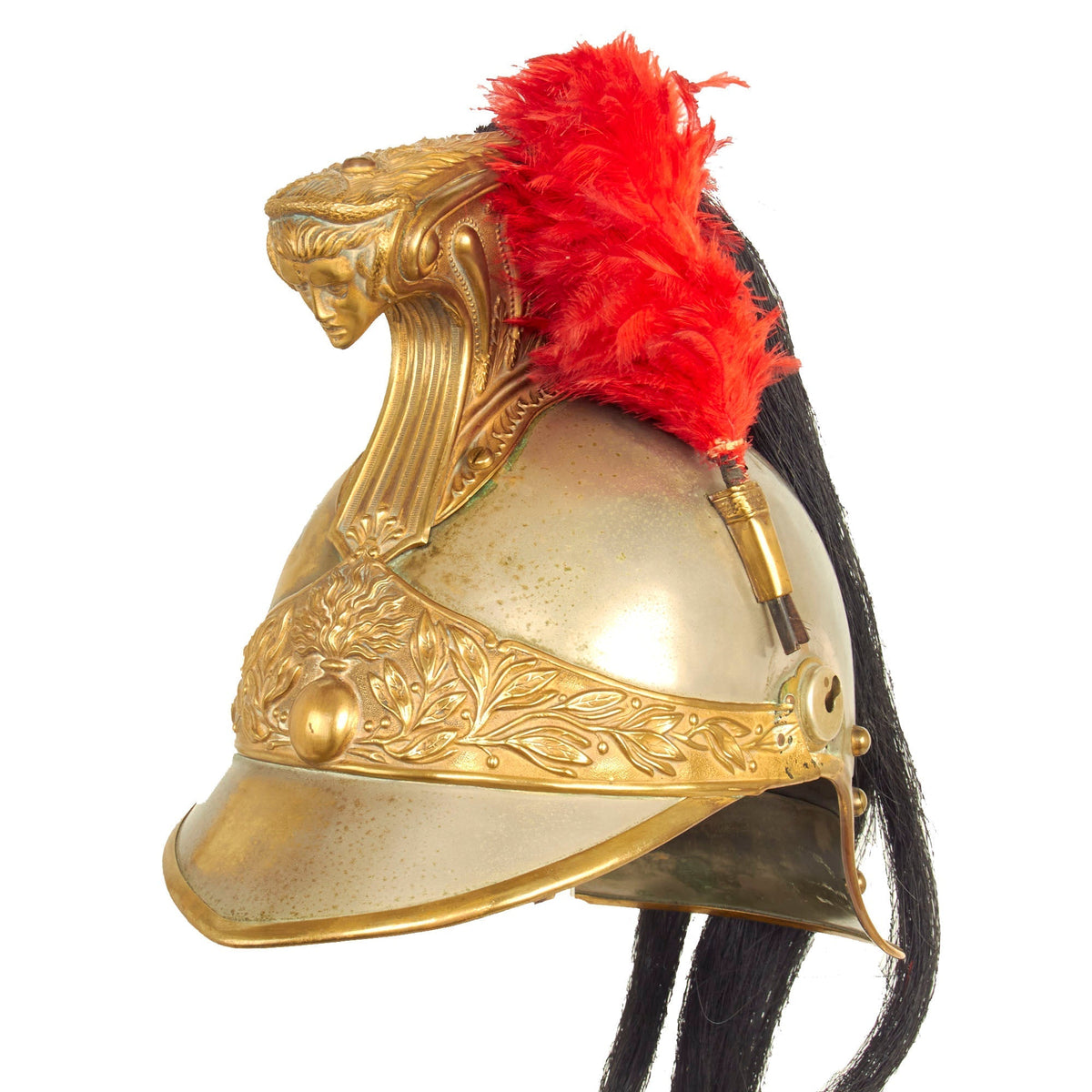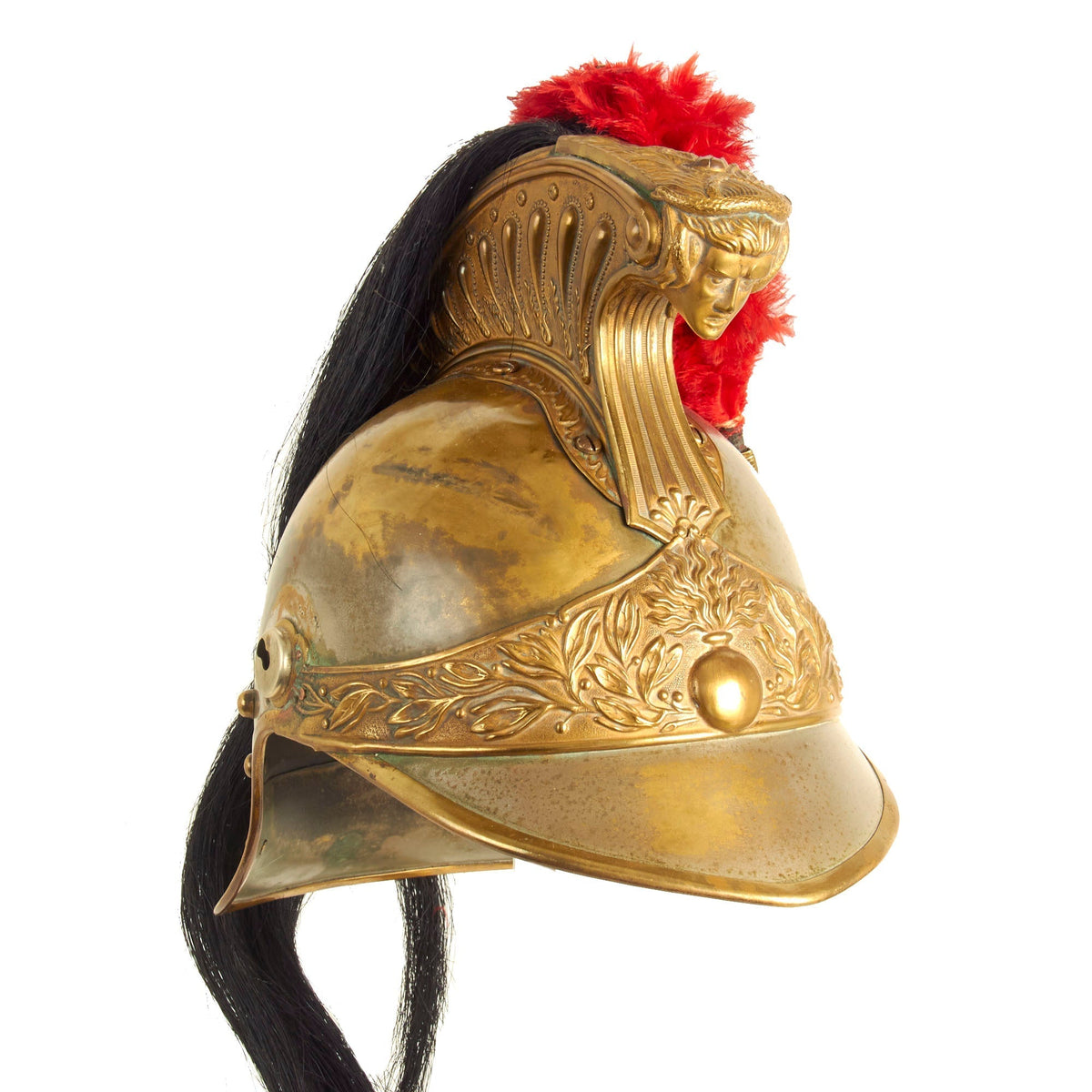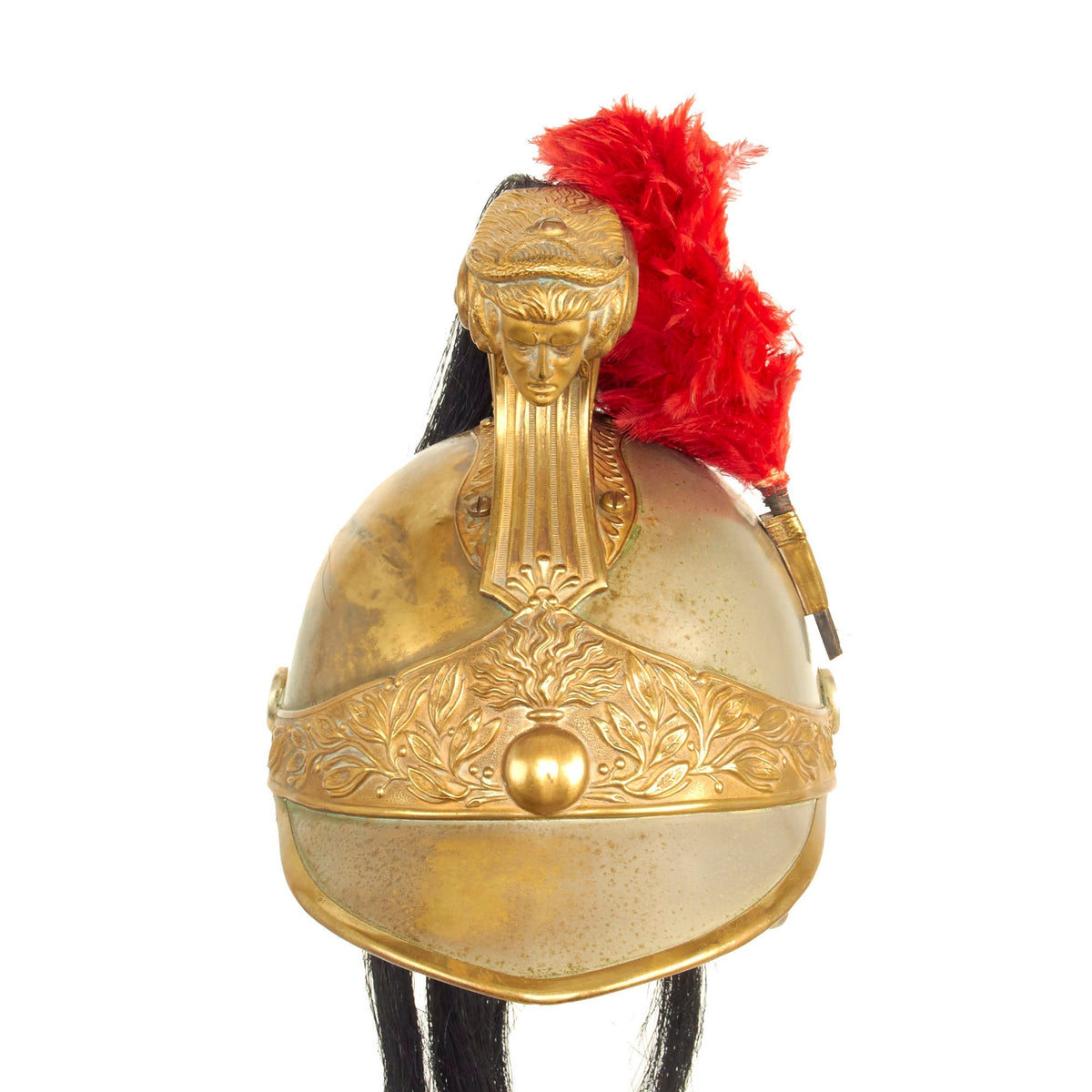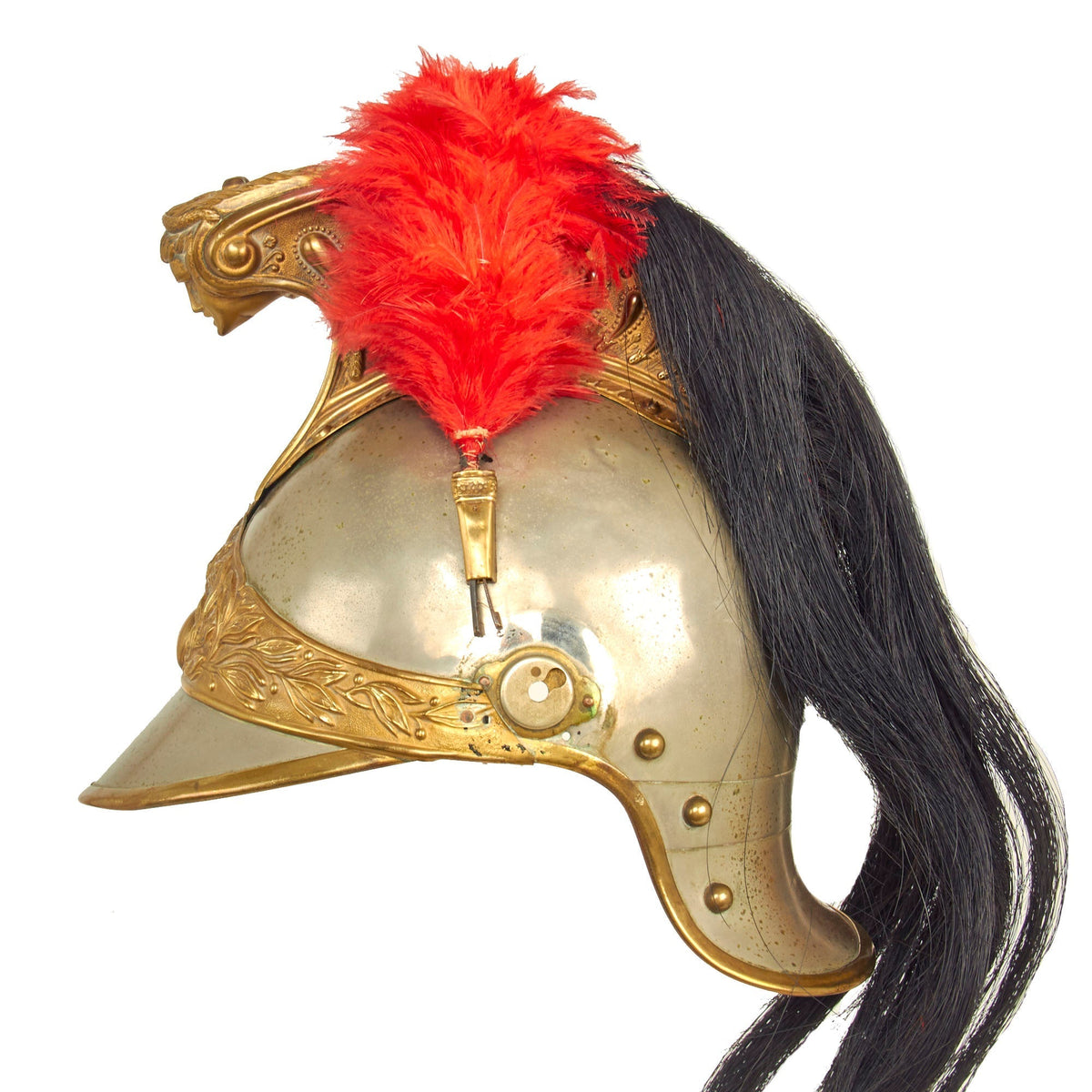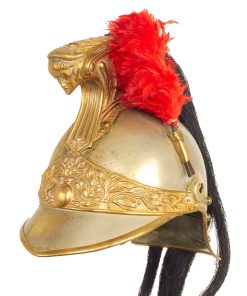Original French Model 1874 Plated Brass Cuirassier Helmet Shell with Horsehair Tail & Red Plume Original Items
$ 695,00 $ 208,50
Original Item: Only One Available. This is a wonderful French Model 1874 Cuirassier Helmet, with a rare nickel plated brass shell, something that we do not often see. The examples we have had are almost always made from steel. Attached to this is a brass comb embossed with beaded fluting that terminates with a “Head of Medusa” design. The comb is fitted with the correct black horsehair tail, and is fitted with a red feather cockade plume on the left side.
The brass helmet plate is embossed with a flaming grenade flanked by laurel leaves, with brass bound front and back peaks. The helmet is unfortunately missing the leather backed chin scales that would normally be attached to the fittings on the side, and the interior lining of the helmet is completely gone, making this an example ripe for a full restoration.
Overall condition is very good, showing wear from service and cleaning. This has removed the nickel plating on part of the front visor and the left side of the dome, where there is an old dent.
An impressive piece in any collection! Ready to display as is or restore!
A resurgence of armored cavalry took place in France under the rule of Napoleon Bonaparte, who increased the number of armored regiments from one to, ultimately, sixteen (fourteen cuirassier regiments plus two Carabiniers-à-Cheval regiments).
During the first few decades of the 19th century most of the major states of Europe, except Austria which had retained its armored cavalry, readopted the cuirass for some of their heavy cavalry in emulation of the French. The Russians fielded two divisions of armored cavalry, but most other states armored a few senior regiments: Prussia three regiments, the Kingdom of Saxony three, the Kingdom of Westphalia two, Spain one (Coraceros Españoles) and the Duchy of Warsaw one. The three Household Cavalry regiments of the British Army (1st and 2nd Life Guards and Royal Horse Guards) adopted cuirasses shortly after the Napoleonic Wars as a part of their full dress uniforms, but never had occasion to wear the armor in battle. However as late as 1887 these regiments were still wearing cuirasses on maneuvers in “field day order”.
Cuirassiers were generally the senior branch of the mounted portion of an army, retaining their status as heavy cavalry—”big men on big horses”. Their value as a heavy striking force during the Napoleonic Wars ensured that the French, Russian and Prussian armies continued to use cuirassier regiments throughout the 19th century. The Austrian cuirassiers were abolished in 1868.
For reasons of climate and cost cuirassiers of the 19th century type seldom appeared outside Europe and Latin America. However Ranjit Singh’s Sikh Army (the Khalsa) of the 1830s included two regiments of cuirassiers equipped and armed in French fashion. Four hundred carabinier cuirasses were imported from France while helmets and uniforms were manufactured in Wazirabad.
Franco-Prussian War
The last occasions when cuirassiers played a major tactical role as shock cavalry wearing traditional armor, was during the Franco-Prussian War of 1870-71. The French cuirassiers numbered 11 regiments at the outbreak of war but had not seen active service since the Battle of Waterloo. A brigade comprising the 6th and 9th Regiments had served in the Crimean War but had not actually encountered the enemy. Accordingly, the prospect of action against the Prussian Army, which included 10 cuirassier regiments of its own, was seen as an opportunity for a strongly traditional branch of the French cavalry to prove its continuing relevance. In the event, in a series of massed charges against Prussian infantry and artillery at Froeschwiller and Rezonville, the French cuirassiers suffered very heavy losses for little return.
Fast Shipping with Professional Packaging
Thanks to our longstanding association with UPS FedEx DHL, and other major international carriers, we are able to provide a range of shipping options. Our warehouse staff is expertly trained and will wrap your products according to our exact and precise specifications. Prior to shipping, your goods will be thoroughly examined and securely secured. We ship to thousands clients each day across multiple countries. This shows how we're dedicated to be the largest retailer on the internet. Warehouses and distribution centres can be located throughout Europe as well as the USA.
Note: Orders with more than one item will be assigned a processing date depending on the item.
Before shipping before shipping, we'll conduct a thorough inspection of the items you have ordered. Today, the majority of orders will be delivered within 48 hours. The delivery time will be between 3-7 days.
Returns
The stock is dynamic and we cannot completely manage it because multiple stakeholders are involved, including our factory and warehouse. So the actual stock may alter at any time. It's possible that you may not receive your order once the order has been made.
Our policy is valid for a period of 30 days. If you don't receive the product within 30 days, we are not able to issue a refund or an exchange.
You can only return an item if it is unused and in the same state as the day you received it. You must have the item in its original packaging.
Related products
Uncategorized
Uncategorized
Uncategorized
Armored Burgonet Helmet & Polearm from Scottish Castle Leith Hall Circa 1700 Original Items
Uncategorized
Armoured Fighting Vehicles of the World: AFVs of World War One (Hardcover Book) New Made Items
Uncategorized
Uncategorized
Uncategorized
Uncategorized
Uncategorized
Uncategorized
Uncategorized
Angolan Rebel 1970s era 60mm Inert Display Mortar from Angolan Civil War Original Items
Uncategorized
Uncategorized
Uncategorized
Uncategorized
Band of Brothers ORIGINAL GERMAN WWII Le. F.H. 18 10.5cm ARTILLERY PIECE Original Items
Uncategorized
Uncategorized
Uncategorized
